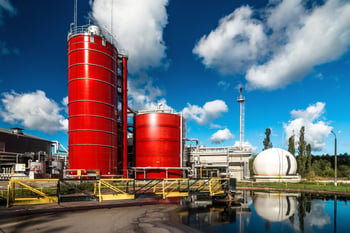The uptake of methanization by industry is gaining momentum all the time for the treatment of residual sludge, of course, but also of liquid industrial effluents. But there are a number of criteria to be met to ensure optimal efficiency... These include a sufficiently large organic load and the addition of a traditional biological treatment.
Originally restricted to recovering agricultural byproducts for reuse, methanization technologies have been the focus for a great deal of research and development work since the 1970s. The goal of these R&D efforts was to adapt these processes for the treatment of industrial liquid effluents. These technologies hold out the promise of lower plant energy bills and residual sludge volumes, at the same time as limiting the footprint of wastewater treatment plants. These days, we hear a lot about industrial decarbonization, but to gain a clear understanding of what it means, we must first remember that the term ‘methanization’ is used to describe an anaerobic biological process for breaking down organic matter.
So before installing a system of this type to treat industrial effluents, it is important to consider whether those effluents are suitable for the process. Because this is not the case for all liquid industrial effluents. To achieve profitable levels of efficiency, the effluents to be processed must be high in carbon, which is generally the case in the food and papermaking industries, for example. Physicochemical analysis of the effluents concerned will answer this question.
Methanization as an upgrade or a new solution

Once the ‘quality’ of the liquid effluent is established, the choice of whether or not to adopt methanization can be based on whether forecasts suggest an increase in planned activity, and therefore a corresponding increase in workload for any existing treatment plant. Adding a methanization stage at the front end of the treatment process will limit the load that will ultimately be imposed on the existing wastewater treatment plant. This can then be achieved without significantly increasing the footprint of the treatment plant. Where an aerobic biological treatment system is already in place, adding a small-scale anaerobic digester can significantly increase the treatment capacity of the plant, especially for organic pollution (COD) concentrations above 2,000 mg/L.
The methanization option may also be considered by industrial plant operators interested in producing their own biogas. The methanization unit can be installed in an existing wastewater treatment plant or as a new construction. After the essential stage of purification to remove sulfur and/or CO2, the biogas produced - methane (CH4) - can either be consumed on site to fuel a boiler, or be sold to the national gas supply grid operator (usually at a relatively high price) for injection into the gas supply system.
Methanization as a source of savings

Another reason why methanization is an effective way of reducing industrial plant energy bills is that it is more economical to operate. Conventional biological treatments require high levels of mixing, because they rely on bacteria that need oxygen to break down the carbon load. Introducing oxygen into the system requires high levels of energy input.
But the methanization process uses anaerobic bacteria that require no oxygen.
Aerobic treatment also produces large quantities of residual sludge, leaving the production plant operator with higher bills for treating that sludge or spreading it on agricultural land. Methanization produces very little residual sludge. The small amounts of sludge that are produced can be sold for seeding other reactors, for example. A new source of savings. Nevertheless, it is important not to lose sight of the fact that methanization is less efficient than conventional biological treatments. It should therefore be considered primarily as a pre-treatment for liquid industrial effluents for discharge into the natural environment, where strict physicochemical parameters apply.
To find out more and take the next step, download our illustrated guide to methanization!
![[Illustrated guide] Using methanization to treat your effluents and generate energy - A guide](https://no-cache.hubspot.com/cta/default/7160320/edf1079b-0646-43e2-a7e7-18d056620526.png)